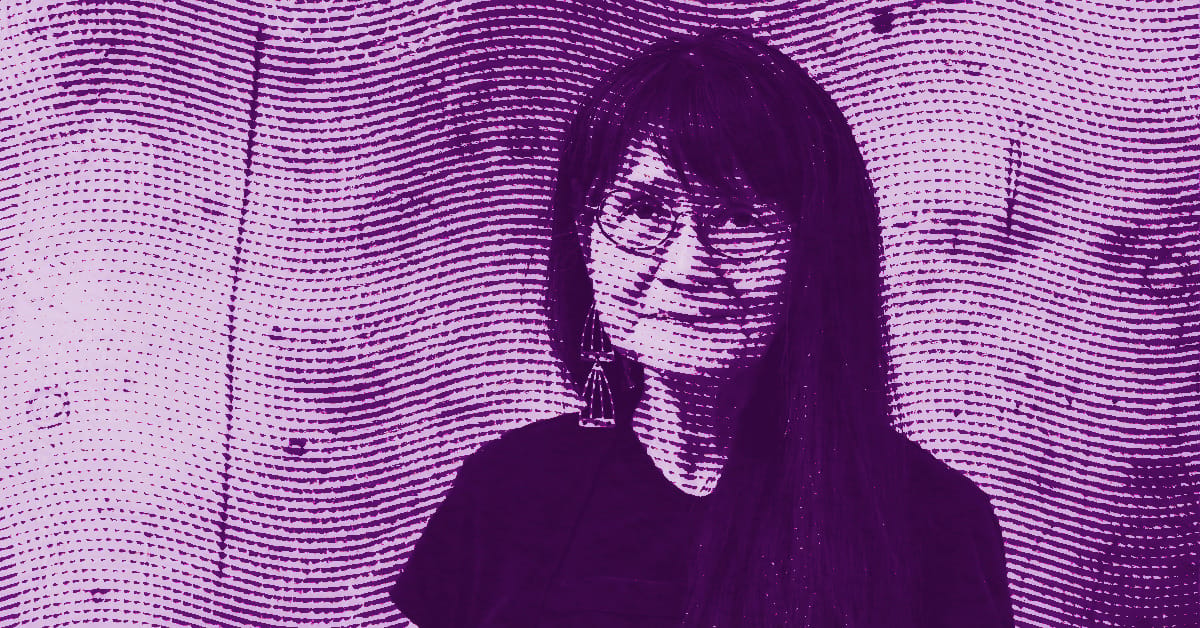Listen to me carefully, you bunch of snobs: Emmi Whitehorse paints like her ancestors wove, with that meticulous patience that transforms colored threads into spiritual cartographies. For more than forty years, this woman member of the Navajo Nation has composed visual symphonies where nature reveals itself in its most intimate nudity, far from Western pictorial conventions that still claim to define what is or is not contemporary art.
Born in 1956 in Crownpoint, New Mexico, Whitehorse belongs to that generation of indigenous artists who refused identity assignments to invent their own plastic language. Her training at the University of New Mexico, where she obtained successively a degree in painting then a master’s in printmaking, confronted her from the start with this fundamental tension between cultural heritage and artistic modernity. But unlike her contemporaries who opted for denunciation or polemical reappropriation, Whitehorse chooses the path of contemplative immersion.
The Architecture of Impermanence
Whitehorse’s work unfolds according to a logic that irresistibly evokes Gothic architecture in its conception of sacred space. Like cathedral builders who sought to materialize the invisible divine, the Navajo artist constructs her compositions according to a spiritual geometry where each element participates in a cosmic balance. Her canvases reveal this same vertical aspiration, this same search for transcendence found in the vaults of Chartres or the rose windows of Notre-Dame. But whereas Gothic art rises toward a Christian God, Whitehorse descends into the telluric depths of her ancestral land.
This kinship with medieval religious architecture is not accidental. Whitehorse’s paintings function as liturgical spaces where the viewer is invited to a form of aesthetic contemplation. Her abstract compositions, crossed with floating signs and symbols, recall illuminated manuscripts where sacred text mingles with ornamental marginalia. Each work becomes a contemporary book of hours, a visual breviary that orders the chaos of the world according to Navajo cosmic rhythms.
The artist proceeds by successive accumulations, layering pictorial layers like stained glass masters assembled their polychrome windows. This stratification technique creates an optical depth that evokes the filtered light plays of great religious edifices. In her recent works exhibited at the 2024 Venice Biennale, notably “Typography of Standing Ruins #3”, Whitehorse pushes this architectural analogy to its conceptual limit: her “standing ruins” suggest these remains of abandoned chapels where nature takes back its rights, where human art returns to its organic substratum.
But Whitehorse does not simply mimic the Gothic aesthetic. She subverts its theological logic to replace it with an indigenous cosmogony where horizontality prevails over verticality, where immanence supplants incarnation. Her “cathedrals” are prairies, her “naves” canyons, her “vaults” the infinite skies of the American Southwest. This paradigmatic inversion constitutes one of the most subversive aspects of her work: she silently dismantles Western spiritual hegemony by opposing it with a spirituality that draws from the pre-Christian sources of humanity.
Architecture becomes a metaphor for cultural memory in Whitehorse’s work. Like those Gothic monuments that bear traces of all their successive modifications, her paintings preserve the stratified memory of Navajo land. Each pictorial layer corresponds to a geological epoch, each symbol to a historical event inscribed in the landscape. This stratified conception of painting makes Whitehorse an archaeologist of the sensitive, an explorer of souls who exhumes truths buried beneath the sediments of colonization.
Light plays the same structuring role in her works as in Gothic art: it reveals, hierarchizes, sanctifies. But while Gothic light descends from heaven to earth, Whitehorse’s light radiates from geological depths to bathe her compositions in a mineral phosphorescence. This inversion of the light source perfectly reflects the difference between a spirituality of elevation and a spirituality of rootedness.
The Alchemy of American Poetry
If Gothic architecture provides Whitehorse with her spatial vocabulary, it is in American poetry that she finds her temporal rhythm. Her compositions irresistibly evoke the prosody of Walt Whitman, that ample and breathed cadence that embraces the vast expanses of the American continent. Like the author of “Leaves of Grass”, Whitehorse practices an aesthetic of cosmic inventory where every natural element finds its place in an overall symphony.
This poetic lineage goes beyond mere stylistic analogy to touch the philosophical foundations of artistic creation. Whitman revolutionized American poetry by abandoning metric forms inherited from Europe to invent a free verse that embraces the natural rhythms of speech and landscape. Similarly, Whitehorse frees Indigenous painting from the aesthetic canons imposed by Western art to regain that primitive organicity that makes art an extension of nature rather than an imitation.
The Whitmanian notion of the “Cosmic Self” finds its plastic translation in Whitehorse. Her abstract self-portraits from the “Self Surrender” series reveal an artistic subject who dissolves into the surrounding nature to better regenerate within it. This dissolution of the individual self into the great cosmic Whole recalls Whitman’s pantheistic ecstasies, those moments when the poet feels “traversed” by the universal energy. In Whitehorse’s work, this fusion is achieved through the mediation of color: her incandescent yellows, abyssal blues, telluric reds function as vectors of mystical communion with elemental forces.
Whitehorse’s very technique evokes Whitman’s writing by its processual and generative character. Like Whitman, who constantly rewrote and expanded his “Leaves of Grass”, the Navajo artist proceeds through endless reprises and variations on the same organic motifs. Her seeds, pollens, and vegetal filaments metamorphose from one canvas to another according to an evolutionary logic that mimics natural cycles of growth and regeneration.
This poetics of perpetual variation situates Whitehorse’s work within the great tradition of Indigenous oral poetry, where each recitation actualizes the myth according to the circumstances of the enunciation. Her paintings function as visual poems that reinvent themselves with each glance, revealing unprecedented associations depending on the viewer’s state of mind and the lighting conditions of the exhibition.
The influence of American poetry also emerges in Whitehorse’s conception of time. As with Whitman or Emily Dickinson, time is not linear but cyclical, marked by biological and cosmic rhythms rather than human history. Her recent works from the “Sanctum” series, painted during the pandemic, reveal this alternative temporality where social isolation becomes an opportunity for reconnecting with the fundamental rhythms of existence [1].
This poetic conception of time explains why Whitehorse refuses any definitive orientation for her canvases, constantly turning them during the creative process. This permanent rotation mimics the seasonal and daily cycles that structure Indigenous temporal experience. Each position of the canvas reveals a different aspect of the represented reality, like those Dickinson poems that change meaning depending on which verse is emphasized.
The Revelation of the Microcosm
“My paintings tell the story of knowing the land in time, of being completely, microcosmically in a place” [2], Whitehorse confides in one of her rare interviews. This phrase condenses the essence of her artistic approach: revealing the infinity of the small, giving to see the invisible proliferation of elemental life that animates every parcel of territory. Her compositions function as poetic microscopes that magnify the imperceptible until it becomes a visual epiphany.
This aesthetic of the microcosm is rooted in the artist’s childhood, spent herding sheep in the desert expanses of New Mexico. This early solitude sharpened her perception of subtle light variations, micro-movements of vegetation, and all those tenuous phenomena that usually escape human attention. Her works translate this sensory hypersensitivity into an extremely subtle plastic language, where each chromatic nuance corresponds to a particular sensation.
Whitehorse’s work reveals an intimate knowledge of the ecosystems of the American Southwest that goes far beyond the superficial observation of a tourist or even a ranch owner. Her references to endemic plants, “Ice Plant XIV,” “Needle and Thread Grass III,” and “Prickly Green II,” attest to an almost scientific familiarity with the local flora. But this botanical precision is coupled with a spiritual dimension that makes each plant species an actor in the Navajo cosmic drama.
The philosophy of hózhó, central to Navajo cosmology, finds in Whitehorse’s art its most accomplished plastic translation. This concept, untranslatable into our language, designates the dynamic harmony that connects all living beings in a network of subtle interdependencies. Whitehorse materializes this holistic vision through her technique of superimposition: her different pictorial layers interact according to an ecosystemic logic where each element influences and modifies all the others.
This systemic approach to painting makes Whitehorse a pioneer of contemporary ecological art. Long before the climate crisis raised awareness in the art world about environmental issues, she was developing a plastic language capable of making visible the interconnection of all natural phenomena. Her works function as scale models of the biosphere, pictorial ecosystems where new relationships between humans and their environment are experimented with.
This ecological dimension takes on a particular resonance in the current context of the sixth mass extinction. The fragile balances revealed by Whitehorse’s canvases remind us of the precariousness of our natural world and the urgency of inventing new modes of coexistence with other species. Her art thus becomes a silent plea for the recognition of the intrinsic dignity of life, beyond its utility for the human species.
Toward a Critical Synthesis
Emmi Whitehorse’s work resists hasty categorizations that would confine it to the ghetto of “Indigenous art” or annex it to the mainstream contemporary abstraction movement. Her uniqueness lies precisely in this synthesis ability that makes diverse artistic traditions dialogue without ever hierarchizing or opposing them. She demonstrates by example that it is possible to be radically modern without denying one’s cultural roots, and to innovate without iconoclasm.
This balancing act makes Whitehorse an emblematic figure of artistic postmodernity, understood not as a particular aesthetic movement but as a critical stance rejecting the grand unifying narratives of Western modernity. Her art offers an alternative to the abstract universalism of the New York School by opposing it with a concrete particularism that does not exclude intercultural communication.
The international recognition that Whitehorse now enjoys, her inclusion in the 2024 Venice Biennale, and her exhibitions in the largest American museums, attest to this evolution of contemporary taste towards more inclusive and less Eurocentric aesthetics. But this institutional consecration must not overshadow the subversive dimension of her work, its silent challenge to established cultural hierarchies.
For Whitehorse’s art operates a Copernican revolution in our relationship to landscape and nature. Where Western pictorial tradition imposes its anthropocentric viewpoint, she substitutes an ecocentric vision that shifts humans from their dominant position to reintegrate them into the community of life. This ontological decentering may be the most precious contribution of her work to contemporary art: teaching us to see the world differently than through the prism of our narcissistic projections.
Whitehorse’s legacy is measured less by the stylistic influence she might exert on the younger generation than by her ability to open new territories to aesthetic experience. By revealing the beauty of the infinitesimal, giving plastic form to the spiritual intuitions of her culture of origin, inventing an abstract language capable of expressing the invisible, she enriches our perceptual vocabulary and makes us more sensitive to the subtleties of the natural world.
This education of the gaze constitutes a major political challenge at a time when humanity must reinvent its relationships with the biosphere. Whitehorse’s art prepares us for this necessary mutation by cultivating that floating attention, that contemplative availability which allows us to perceive life in all its forms. It reminds us that art is not merely aesthetic entertainment but an instrument of knowledge and spiritual regeneration.
In a world saturated with spectacular images and artificial emotions, Whitehorse’s paintings offer a refuge of silence and authenticity. They invite us to rediscover that perceptual slowness, that meditative patience which allows access to essential truths. They teach us that true art does not merely represent reality but reveals it in its sacred dimension, reconciling us with the fundamental mystery of existence.
Emmi Whitehorse’s work constitutes a precious antidote to the desacralization of the contemporary world. By restoring nature to its sacred dimension and revealing the hidden poetry of the humblest phenomena, she helps us re-enchant our relationship with reality. Her art reminds us that we are not only consumers of images but participants in the great cosmic dialogue that unites all beings in a common community of destiny. This lesson of wisdom, delivered by a woman who has managed to preserve her people’s ancestral intuitions while updating them in the language of contemporary art, resonates as a message of hope in our troubled era.
- Michael Abatemarco, “Depth of Field: Artist Emmi Whitehorse”, The Santa Fe New Mexican, January 8, 2021
- Elisa Carollo, “Navajo Artist Emmi Whitehorse’s Symbolic Landscapes Offer a Path to Reconnection With Nature”, Observer, October 2024
















